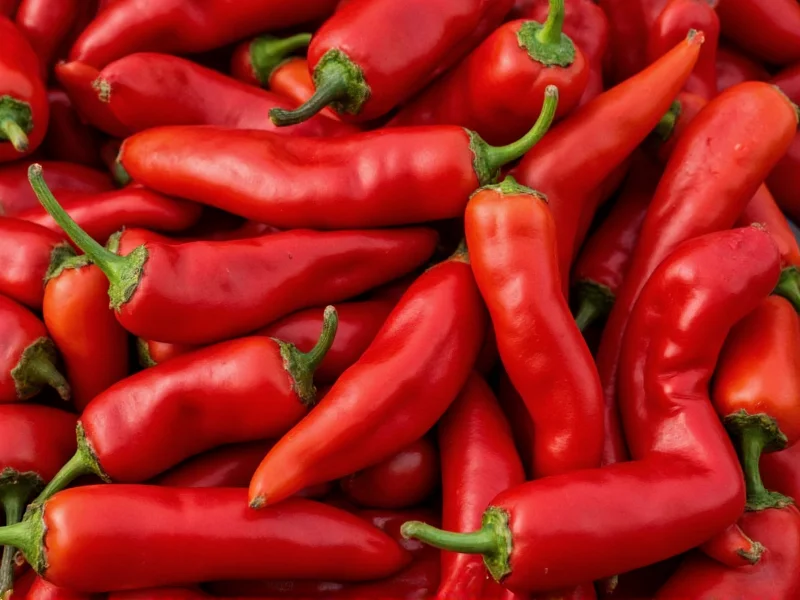Yes, serrano peppers are definitely hot, typically measuring between 10,000 and 23,000 Scoville Heat Units (SHU), making them significantly hotter than jalapeños but milder than habaneros.
Serrano peppers pack a serious punch that can surprise those unfamiliar with their heat level. These small, slender chilies native to Mexico's mountainous regions deliver a clean, grassy heat that builds quickly on the palate. Understanding their precise heat profile helps both home cooks and culinary professionals use them effectively without overwhelming dishes.
Understanding Serrano Pepper Heat Levels
Serrano peppers (Capsicum annuum) rank between 10,000-23,000 Scoville Heat Units on the official Scoville scale, which measures capsaicin concentration—the compound responsible for chili heat. This places them solidly in the medium-to-hot category of peppers, though their heat can vary based on growing conditions, color, and specific variety.
Unlike some peppers that deliver slow-building heat, serranos hit quickly with an intense but relatively short-lived burn. Their thin walls contain capsaicin primarily in the white pith and seeds, meaning removing these parts significantly reduces their heat level while preserving their distinctive flavor.
| Pepper Variety | Scoville Heat Units (SHU) | Heat Comparison to Serrano |
|---|---|---|
| Bell Pepper | 0 SHU | Not applicable |
| Jalapeño | 2,500-8,000 SHU | 2-5 times milder than serrano |
| Serrano | 10,000-23,000 SHU | Baseline |
| Cayenne | 30,000-50,000 SHU | 1.5-2 times hotter than serrano |
| Habanero | 100,000-350,000 SHU | 5-15 times hotter than serrano |
Factors That Influence Serrano Pepper Heat
Several variables affect how hot your serrano peppers will be:
Color Variations
Green serranos (unripe) generally measure around 10,000-15,000 SHU, while red serranos (fully ripe) can reach the upper end of their range at 20,000-23,000 SHU. The ripening process concentrates capsaicin, making red varieties noticeably hotter. Red serranos also develop slightly sweeter, fruitier notes alongside their increased heat.
Growing Conditions
Stress factors actually increase capsaicin production. Serranos grown in:
- Drier conditions tend to be hotter
- Higher temperatures produce more capsaicin
- Poorer soil quality can intensify heat
- Full sun exposure increases spiciness
This explains why the same serrano variety might taste different depending on where and how it was grown—a crucial consideration when following recipes that specify serranos.
Practical Uses for Serrano Peppers in Cooking
Serranos' clean heat and grassy flavor make them versatile in many cuisines. When working with these peppers:
Handling Safety Tips
Always wear gloves when handling serranos, especially when cutting multiple peppers. The capsaicin can transfer to your skin and cause burns, particularly if you touch your eyes or face. Never use bare hands to rub your eyes after handling hot peppers—a common mistake that leads to painful consequences.
Heat Control Techniques
To moderate serrano heat while preserving flavor:
- Remove all seeds and white pith (where 80% of capsaicin resides)
- Soak sliced peppers in vinegar or citrus juice for 15-20 minutes
- Cook with dairy products like yogurt or sour cream to neutralize heat
- Balance with sweet ingredients like honey or fruit
Culinary Applications
Serranos excel in:
- Salsas (especially pico de gallo and salsa verde)
- Marinades for meats and seafood
- Infused oils and vinegars
- Stuffed pepper recipes (when seeds are removed)
- Hot sauces requiring clean, sharp heat
Unlike thicker-walled jalapeños, serranos' thin flesh makes them ideal for raw applications where you want immediate heat without textural interference.
Growing Your Own Serrano Peppers
For gardeners interested in controlling heat levels, serranos are relatively easy to grow:
- Start seeds indoors 8-10 weeks before last frost
- Transplant outdoors when soil reaches 70°F (21°C)
- Provide full sun and well-draining soil
- Water consistently but avoid overwatering
- Harvest when peppers reach 2-4 inches long
To increase heat, slightly stress plants by reducing water as peppers mature. For milder peppers, maintain consistent moisture. Remember that serranos will continue to ripen and increase in heat after picking, so use green peppers promptly if you prefer less heat.
Common Misconceptions About Serrano Heat
Several myths persist about serrano peppers:
- Myth: All serranos are equally hot
Reality: Heat varies significantly by plant, growing conditions, and ripeness - Myth: Smaller serranos are always hotter
Reality: Size doesn't reliably indicate heat level—chemical analysis is needed - Myth: Cooking eliminates serrano heat
Reality: Heat remains largely intact, though distribution changes
Understanding these nuances helps cooks manage serrano heat effectively rather than fearing these versatile peppers.
When Serranos Might Not Be the Best Choice
While excellent for many applications, serranos aren't ideal when you need:
- Very mild heat (choose jalapeños or poblanos instead)
- Thick flesh for stuffing (opt for larger jalapeños)
- Extreme heat (habaneros or ghost peppers would be better)
- Sweet pepper flavor (try banana peppers or cubanelles)
Recognizing these limitations helps prevent culinary disasters when substituting peppers in recipes.











 浙公网安备
33010002000092号
浙公网安备
33010002000092号 浙B2-20120091-4
浙B2-20120091-4